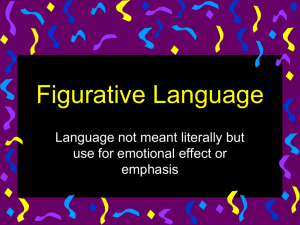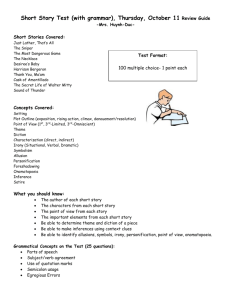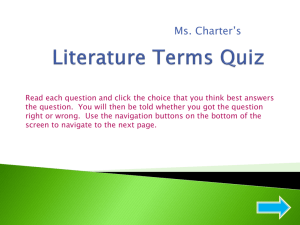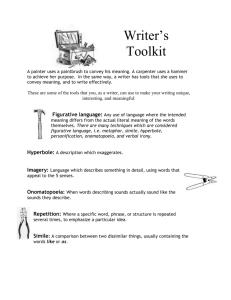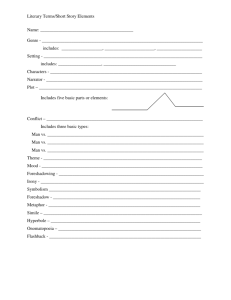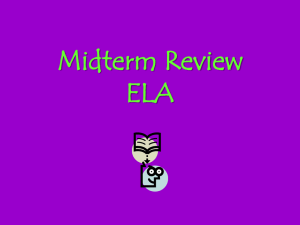Figurative Language
advertisement
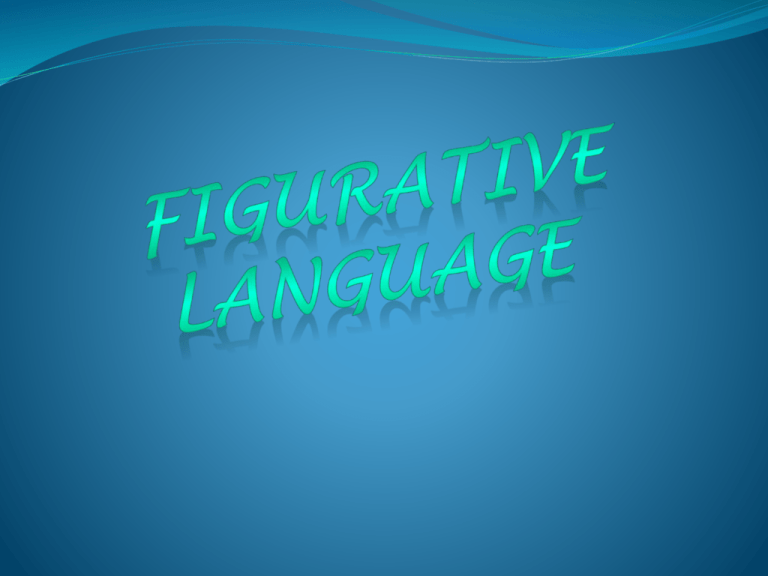
Simile A simile is a comparison between two objects in which the two objects are essentially different but they share some kind of likeness. The idea is to use the comparison directly with the words "like," or "as." For example, "Her feet were as cold as ice." Metaphor A metaphor is a comparison between two objects in which the two objects are essentially different but they share some kind of likeness. The idea is to use metaphoric comparison in place of a word which directly describes the original subject without the use of "like" or "as." For example, in George Seville's "Maxims," he writes, "Men's words are bullets, that their enemies take up and make use of against them." Apostrophe Apostrophe is when you address someone or something which is absent or literally cannot listen. Examples would include any letters to people who are no longer alive, or, depending on the approach, prayer. A perfect example is Lorenz Hart's song "Blue Moon”, where he addresses the moon about his loneliness. Personification Personification is the addition of human characteristics to a material object. Perfect examples of personification can be found in animated films. Pixar has made millions off films centered around personification such as "Toy Story," "Cars," and "The Brave Little Toaster." Hyperbole Hyperbole is the use of exaggeration. Teenagers are regular pros at using hyperbole without thinking about it. In Robert Frost's poem "After ApplePicking," he uses hyperbole in the phrase "ten thousand fruit to touch." On another level you can remember hyperbole with the use of "Your mama is so fat..." jokes. Understatement Understatement, or litotes, is the opposite of hyperbole in that rather than imply that something is much more than it seems, understatement implies that something is much less that what it really is. It often comes across as sarcastic as in Holden Caulfield's statement from "Catcher in the Rye," "I have to have this operation. It isn't very serious. I have this tiny little tumor on the brain." Onomatopoeia Onomatopoeia is the use of words that imitate sounds. Many people associate onomatopoeia with baby books which emphasize the sounds that animals make, however it's used much more regularly in conversation when telling personal anecdotes. A tip for remembering onomatopoeia is to think of "Knock-Knock" jokes. The name of the type of joke itself uses onomatopoeia. Irony Irony is when a statement or situation is contradictory to what is expected. Many times the situation is exactly opposite of what it may appear to be. There are many types of irony, the two most common being verbal irony and dramatic irony. * Verbal irony occurs when either the speaker means something totally different than what he is saying or the audience realizes, because of their knowledge of the particular situation to which the speaker is referring, that the opposite of what a character is saying is true. Verbal irony also occurs when a character says something in jest that, in actuality, is true. * Dramatic irony occurs when facts are not known to the characters in a work of literature but are known by the audience. Paradox A paradox is a statement or situation which seems false on the surface but can be true upon closer inspection. For example, in "1984" George Orwell uses the phrase "ignorance is strength." This idea of ignorance is contrary to what is taught in school but when given thought anyone can think of examples where someone was able to achieve more for themselves when ignoring the needs or feelings of others (consider slavery). Oxymoron An oxymoron is a figure of speech in which apparently contradictory terms appear in conjunction. E.g.- “Faith unfaithful kept him falsely true. “We ate jumbo shrimp for dinner.” Symbol A symbol is an object representing something else. It can represent another person, an idea or a significant event. The use of color in writing can also be symbolic in that colors have connotations that people associate with them. Students can get a better idea of symbolism from studying Greek mythology. For example, in the story of Daedalus and Icarus, the wings that Daedalus builds represent freedom
